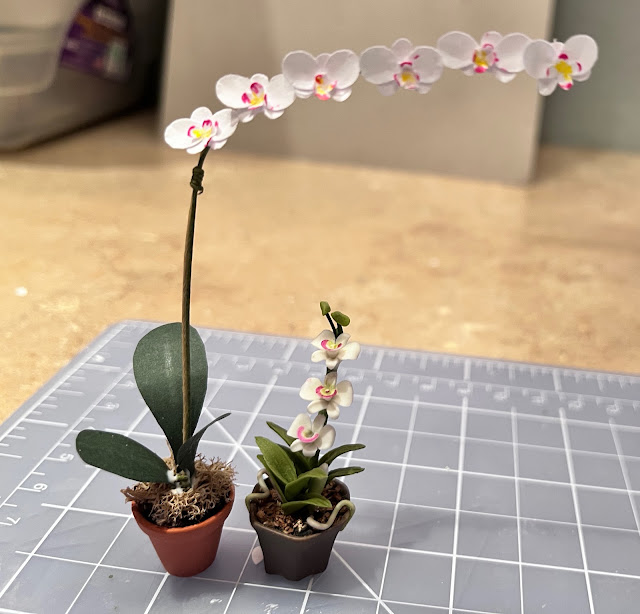Sometimes I get confused, like when I'm at Home Goods looking a the beautiful home decorating accessories and I see a pretty vase or interesting wall art and I think to myself: "That would look really cool in the Manchester." Then I have to remind myself that I'm out of the basement and in a real store and that vase won't fit in the dollhouse.
Right in the middle of measuring the window, a friend called whom I hadn't heard from in a long time, interrupting my "work". She's newly retired and is bored and hasn't found ways to fill her time. I modestly confessed to working on the dollhouse a good share of the day.
And dinner was late tonight because I got so engrossed in getting the wallpaper template for the wall in the addition just right. Fortunately I had put ribs in the slow cooker and our appetites are still on Mountain Standard Time. As I came upstairs to finish supper, hubby was just going out to feed POP the pony, so I knew I had time to finish up meal prep.
I willing admit to be my obsession with my miniature world. Some miniaturists who took up the hobby last year call their project their Covid House. The Manchester does fit in that category simply because that's how I spent my covid isolation, which for me really wasn't much of change from my regular post retirement activities. My phone visit with my old friend reminded me how important its is keep busy after a long career ends. As a retired couple, my husband I have flourished because of our many interests and hobbies. Regardless of age or state of life, it's important to have interests that fulfill the Inner You and a nourish your spirit.
So, here's what has kept me entertained the last few days.
I started playing around with the addition living room, trying to decide what wallpaper to use. I downloaded a striking leaf pattern from Jessica Cloe Minis store on Etsy. I love the subtle green leaves. The theme for this house seems to be taking on a botanical feeling, so this wallpaper is perfect. Right now it's printed on computer paper (8.5x11), which is a perfect width printed in landscape orientation, but a wee bit short on the bottom. I had hoped not to have to install crown molding to avoid those darn mitered corners, but I may have to install crown molding to cover the gap.
With the wallpaper temporarily in place, I began playing with accessories, added the table, found a black horse to go with the lamp, added some red books, and little birdhouse. Then I realized that I needed furniture.
I hadn't upholstered it yet, so that's how I spent part of Sunday. You can view that furniture making project by clicking here: Mid Century furniture. The furniture is designed and created by Rita who offers the .svg files on Etsy and provides the instructional tutorial on her web site. It is a nice beginner's project for both a cutting machine and learning how to upholster.
The room needed more than one chair and needed something in the corner, so I dug out the unfinished projects stash and found this chair designed by Julie Warren. It's perfect for that spot, except I can't decide on a fabric for the upholstery.
Because Rita has such a great tutorial, I'm not going to go into detail on the how to's, but I will share my difficulties. You can visit her website to learn more about her furniture: Dilly Dally Dollhouse.
I'm not quite finished with the cushions because I ran out of adhesive to add the edging on the sofa seat cushion.
So, you will see the the cushions on the chair are flat and square while the ones on the sofa are puffy.
Originally I cut the cushions from 1/4 inch foam board and added a lay of fiber fill to soften the cushion. The fiber fill was too thick and the back cushion was cut 1.75"x1.75" making it too tall for the back of the chair; I wasn't sure that the edging would look right with the puffiness.
A note here: I sort of experimented with adhesives. Most use tacky glue to adhere fabric. Julie Warren uses her favorite wood glue to adhere everything, including cloth, but I make such a mess with these glues, so I used double stick carpet tape to adhere the fiber fill and to hold the fabric in place. It's a very strong tape because it is used to splice carpet pieces together, so it has a sticky grip. It's somewhat forgiving and can be lifted and repositioned. I like using tape instead of glue because the glue tends to saturate the fabric and get's all over your fingers and clogs up the fiber fill. I used the Elmer's stick glue to hold the folded corners on the back of the cushion in place. It takes a while for it set, and it's what Rita uses in her tutorial.

You can see in this photo the problem with the chair back. I did a pretty poor job of covering the cushion. I cut the cloth too large and had too much to fold over on the back making the cushions bulky, and the back cushion too tall, so a redo was necessary.
Now you can see a cleaner look on the top 2 chair cushions. The 3rd is the old cushion; while it looks nice, it's too large. I left out the fiber fill for a cleaner look, creating a more defined square cushion, but I didn't recut the and recover the sofa cushions, so they are puffy. I think I will redo them without the fiber fill to match the chairs.
While I was able to neatly glue down the fabric on the back side of the sofa, I had trouble with the chair cushions, so I cut another square to cover the folds on the corners. I certainly need more practice at upholstery.
I have reviewed Julie's YouTube tutorial on covering her chair. I forgot how work intensive that project is. I need to find a fabric other than green. The room has a lot of green already.
I love how the table turned out. I had no idea as to what to put on it, but as I poked around in my stash, I got excited with what I already had on hand. All of my houses will have a horse in some form. The little bird house just seems to naturalize the room. On the bottom shelf, red books add that bit of pizazz and breaks up all of the green. The brass lamp adds a touch of elegance. It might be considered the jewelry in the room.
The little house on the bottom shelf has special interest for me. I bought it in Ireland and it seems perfect for the shelf instead of hidden in the guest bedroom where I go only to ready the room for company. The photo doesn't pick up the red door. Red adds a spot of interest, especially in a rather monochromatic color scheme.
And the table. You have seen it in past posts as I use it to display little things. I made it for the Bellingham balcony as a plant stand, but didn't like it there, so it has bounced around the stash. It appeared in last week's post, unpainted as a prop for the lamp and to display my daisies.
So I painted it white, but white is boring, and the remaining walls will be white, so I decided that it wouldn't be a new table; it would be a refurbished garage sale find. I gave it a layer of white acrylic paint then sanded down the white to expose bare wood then covered it with olive green let it cure then sanded it like crazy with a 220 rough sandpaper to expose white paint and bare wood.
The table now has character and looks well used and keeps the living room from looking so artificial.
I raided the Bellingham attic and found two little pitchers of flowers that had made for the Bellingham, but didn't use. Which should I keep, the pink or the green?
My dollhouses all have a dog or two on the front porch and at least one cat. The Pink Farm House has a doberman and collie along with a couple of siamese cats. The Bellingham has two German Short Haired Pointers, our dog of choice here and two or three cats, including a calico that reminds us of our barn cat, Callie.
Ziggy and Sabrina begged to come by the fire. Last night was really cold, another freezing night. You know that Ziggy is giving Sabrina that look: "You know you are not allowed on the furniture." The inspirational Ziggy is honored to have miniature named after him and Sabrina, a lynx siamese, is too busy running around the pasture trying to keep up the kids to pay attention.
Finally I settled on this William Morris paper to use as wallpaper, another download, that I stumbled on while looking at Pinterest, which led me to a site that has royalty free images, Raw Pixel, and free downloads. I've become obsessed with his work, lately. Because this paper is so bold, I may not use the Jessica Cloe paper. The final wallpaper will be printed on photographic mat paper because it is heavier and sealed with a Krylon sealer to protect the color.
I'm working on each room one by one now, trying to get each room finished before I move on to the next. The completion list includes these projects:
- glue the floor in place
- stain the step,
- trim the doorway between the rooms
- wallpaper
- curtains and curtain rod
- baseboard and window trim
- maybe crown molding
- maybe a ceiling light, which I am still pondering. It's a brass chandelier that doesn't really seem to fit in the room, so I may add wall sconces instead
- Decorate the entertainment center with books and baubles.
Have I forgotten anything?
That is my plan for the next few days.
I am so glad that you stopped by.
Thank you for visiting.


























































